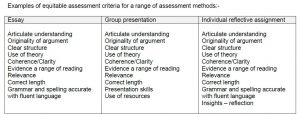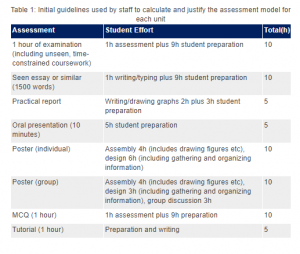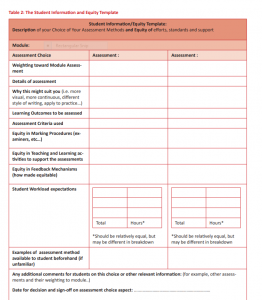How does it align with the module learning outcomes? Does it assess skills and knowledge that are key to the discipline?
- Consider the choice of module. Not all modules may be suitable for choice. Could this be part of a pattern of programme assessment?
- Consider learning outcomes for the module and the types of assessments that might meet these.
Offering choice or flexible assessment MUST still allow students to meet the learning outcomes of the module or programme.
3. Consider the validity of the assessment, i.e. is it assessing what you want it to assess or is it requiring extra skills that are not part of the learning outcomes? For example, if ‘evaluating a patient’s diet’ is a learning outcome, this can be done in many ways. If ‘evaluating a patient under high stress situations’ is a learning outcome, assessment options may be reduced. Often we assess something in the way we are familiar with rather than considering other options which may enable students to achieve and demonstrate the learning outcomes using different abilities. Plymouth University’s project shows some examples:

For ideas on different types of assessments, share ideas with colleagues or browse this resource.
If you are worried about rigour, read the SEEC guidelines which justify this type of flexibility in assessment. Do ensure that your assessments BOTH meet QAA requirements for the level and discipline. This should reassure external examiners in addition to with examples and preferably with feedback from students (see page xxx of UCD resource).
When will it occur in the term/module? How will I mark it? Will I grade it? What criteria will I use?
Grades, weightings and criteria should be factored into the assessment design template and made clear to students in assessment briefs.
It is good to think about workload and amount of student effort rather than thinking in terms of word count. Manchester Met University has conducted work on determining hours of effort to justify equivalences. As described above, to ensure equity all different assessment methods need to share similar marking criteria, as learning outcomes should be the same.

One concern is that different markers are likely to have different experiences and attitudes towards a variety of formats, including unfamiliarity with various formats, personal preferences and socio-cultural assumptions about the effectiveness or appropriateness of each format for academic work. This highlights the importance of tutor discussion and standardisation sessions prior to marking to unearth staff perceptions and biases about assessment formats (Bloxham, 2016).
As with all assessments in this resource, criteria should be available to students prior to starting work on the assessment (On KEATS, handbook etc) and preferably, discussed with students in class or online through use of exemplar training (link to page).
Follow a template for setting assessment choices:
University College Dublin has a ready-to-go-template

How will I give formative opportunities for practice? When will it occur in the term/module?
Formative assessment or opportunities for practice can become tricky when assessment is chosen by and especially when co-designed by the student. One approach to formative assessment could require students to evidence how their work meets the assessment criteria in plans and outlines.
Students who are doing the same assessment can be paired together to give formative feedback.
Consider whether, based on feedback, should students get a chance to make a different choice. This is not necessarily practical within most courses, and can lead to chopping and changing (and gaming the system!) rather than working on acquiring skills/knowledge for the originally chosen assessment.
How will I address potential challenges?
Do I need to make any modifications for accessibility/inclusivity? Can I build these into the design?
As the idea of assessment choice is based on universal design, students will be given the opportunity to assess their own abilities and choose an assessment that suits them. However, in spite of this, there may still be issues of accessibility for students with hearing or sight impairments etc. There should still be a provision for MCFs and be prepared to factor in reasonable adjustments if needed.
Do I need to make any modifications for large cohort sizes?
Limit the number of assessments to two in order to avoid having a range of different assessments to mark across a wide cohort. The UCD resource is a good example of how this has been done.
Anecdotally, assessment choice works better with smaller classes when there is more time and space to talk through choices with students.
How can I introduce it to students?
Prepare your students by discussing the differences between the given assessment choices. It will also be helpful to provide examples of the choice along with clear assessment criteria to help students understand the difference.
Talk through your marking processes and involve students as much as possible in the negotiation of criteria.
